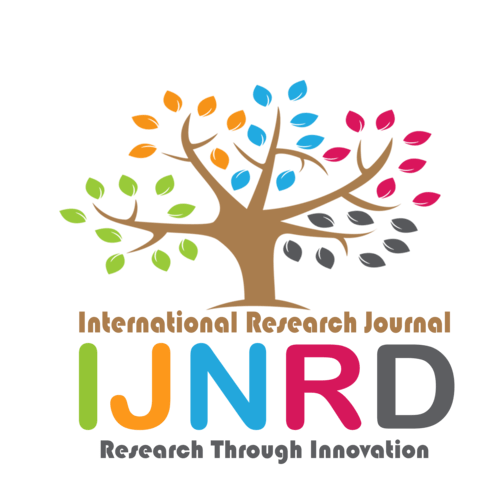|
|||||||||||||||

|
INTERNATIONAL JOURNAL OF NOVEL RESEARCH AND DEVELOPMENT International Peer Reviewed & Refereed Journals, Open Access Journal ISSN Approved Journal No: 2456-4184 | Impact factor: 8.76 | ESTD Year: 2016 Scholarly open access journals, Peer-reviewed, and Refereed Journals, Impact factor 8.76 (Calculate by google scholar and Semantic Scholar | AI-Powered Research Tool) , Multidisciplinary, Monthly, Indexing in all major database & Metadata, Citation Generator, Digital Object Identifier(DOI) |
||||||||||||||
Issue: May 2024
Volume 9 | Issue 5
Review Result and Publication of Paper within : 2-3 days
Click Here For more DetailsFor Authors
Forms / Download
Published Issue Details
Editorial Board
Other IMP Links
Facts & Figure
Impact Factor : 8.76
Issue per Year : 12
Volume Published : 9
Issue Published : 96
Article Submitted :
Article Published :
Total Authors :
Total Reviewer :
Total Countries :
Indexing Partner
Join RMS/Earn 300
Licence
This work is licensed under a Creative Commons Attribution-NonCommercial 4.0 International License







|
Published Paper Details
|
|
| Paper Title: | A STUDY TO EVALUATE THE EFFECTIVENESS OF STRUCTURED TEACHING PROGRAMME ON KNOWLEDGE AND PRACTICE REGARDING INFECTION CONTROL STANDARDS AMONG HEALTH CARE PERSONNEL WORKING IN LABOUR UNIT AT SELECTED HOSPITALS,ERODE DISTRICT. |
| Authors Name: | MS.BOOMANI.G |
| Download E-Certificate: | Download |
| Author Reg. ID: |
IJNRD_203674
|
| Published Paper Id: | IJNRD2308161 |
| Published In: | Volume 8 Issue 8, August-2023 |
| DOI: | |
| Abstract: | A STUDY TO STRUCTURED TEACHING PROGRAMME ON KNOWLEDGE AND PRACTICE REGARDING INFECTION CONTROL STANDARDS AMONG HEALTH CARE PERSONNEL WORKING IN LABOUR UNIT AT SELECTED HOSPITALS, ERODE DISTRICT DR.PROF.JAMUNARANI1, MRS.KALAMANI.P2, MS.BOOMANI.G3 1. Principal, Medical Surgical Nursing Department,(affiliated to the Tamilnadu Dr.M.G.R. Medical University, Chennai) Sresakthimayeil Institute of Nursing and Research (JKK Nattraja Educational Institutions), Namakkal, Tamilnadu, India. 2. Professor, Obstetrical and Gynecological Nursing Department,(affiliated to the Tamilnadu Dr.M.G.R. Medical University, Chennai) Sresakthimayeil Institute of Nursing and Research (JKK Nattraja Educational Institutions), Namakkal, Tamilnadu, India. 3. M.sc(N) Student, Sresakthimayeil Institute of Nursing and Research (JKK Nattraja Educational Institutions),(affiliated to the Tamilnadu Dr.M.G.R. Medical University, Chennai) Corresponding author: boomaniboomani3@gmail.com ABSTRACT Infection prevention and control is integral to safe, effective and ethical nursing practice. Ensuring the use of infection control standards is an important component of nursing. Worldwide escalation of the use of infection control standards will endorse quality promotion of health care which is safe for mother and health care personnel in labour unit. The aim of the study was to evaluate the effectiveness of infection control standards on knowledge and practice among health care personnel working in labour unit at selected hospitals. The selection of sampling technique is purposive sampling technique and the sample consists of 60 health care personnel working in labour unit, Erode. The research approach used in this study was quantitative research design. The research design adopted for the present study was one group pretest posttest pre experimental design. INTRODUCTION Women are special creatures of god because she has the capability to give birth. She is crossing many developmental stages such as newborn, infancy, childhood, adolescence, adulthood and many vital events such as attaining menarche, pregnancy, childbirth and menopause. Women are typically capable of giving birth. Childbirth is momentous occasion in the life of couple. There is no greater gift for a mother than a healthy newborn baby and being healthy thereafter the delivery. More over healthy women are the foundation of a strong community and healthy newborns are the future. The WHO (2005) launched an infection control campaign “clean care is safer care” as part of its global patient safety challenge. The infection control campaign placed hand hygiene as its first priority and guidelines in hand hygiene have been developed using recommendations based on evidence. The centre of disease control and prevention (CDC’s) (2006) “Guideline for hand hygiene in health-care setting “recommends that gloves must be worn according to standard and contact precautions. Over them, many studies have demonstrated the effectiveness of gloves in allowing health care workers to avoid introducing infection to patients and as well as personal protective measure. The other major concern emerged as an issues in health care setting is biomedical waste management which has become a worldwide humanitarian topic today. The Biomedical waste (Management and rules 2011) has clarified the ambiguity and allotted one color to each category of waste which was inculcated in infection control policy. NEED FOR STUDY Pregnancy is a time of joy and excitement.Labour, the culmination of pregnancy, is the start of an incredible journey with great psychological, social and emotional, meaning for the mother and her family. During this incredible journey of childbirth, a women’s genital tract. A bare surface prone to infections which are introduced by certain invasive procedures routinely done in labor unit such as vaginal examination, urinary catheterization, and artificial rupture of membrane, instrumental deliveries and also by the substandard level of infection control practice. The burden of this disease resulting from infection has led to a revival of general interest in infection control. Infection prevention and control is integral to safe, effective and ethical nursing practice. Ensuring the use of infection control standards is an important component of nursing. It aims to avoid infection (i.e. primary prevention) by enhancing practices of hand hygiene, surgical asepsis, environmental hygiene, clean equipments’ and training of health care OBJECTIVES OF THE STUDY 1. To assess the pre-test level of knowledge and practice scores regarding infection control standards among health care personnel working in labour unit. 2. To assess the post-test level of knowledge and practice scores regarding infection control standards among health care personnel working in labour unit. 3. To compare pre and post-test level of knowledge and practice scores regarding infection control standards among health care personnel working in labour unit. 4. To correlate the post test level of knowledge and practice scores regarding infection control standards among health care personnel working in labour unit 5. To associate post test level of knowledge and practice on infection control standards with their selected demographic variable among health care personnel working in labour unit. RESEARCH VARIABLES Independent variables Independent variable in this study was infection control standards. Dependent variables The dependent variable in the study was knowledge and practices on infection control in labour unit among health care personnel. Extraneous variables The extraneous variables were age, professional qualification, designation, and total year of experience in labour unit. SETTING OF THE STUDY: The study was conducted at Adithya hospital-bhavani 50 beded for maternity and 25-30 deliveries per month are conducted.10 health care personnel are working in labour unit. Ashok Krishna hospital-bhavani 60 beded for maternity and 40-45 deliveries per month are conducted.20 health care personnel are working in labour unit. Surya maternity and children’s hospital-bhavani 50 beded for maternity and 25-30 deliveries per month are conducted.15 health care personnel are working in labour unit. Kalyani nursing home-bhavani 60 beded for maternity and 30-35 deliveries per month are conducted.15 health care personnel are working in labour unit RESEARCH DESIGN The research design adopted for the present study was one group pretest posttest pre experimental design. The researcher conducted the study in selected hospitals at Erode District. The aim of the study was to evaluate the effectiveness of infection control standards on knowledge and practice among health care personnel working in labour unit using purposive sampling technique. SAMPLE SIZE A sample of 60 health care personnel who fulfilled the sample criteria were selected for the study SECTION-I Table - 4.1 Frequency and percentage distribution of demographic variables of health care personnel with respect to age, professional qualification, designation and total year of experience in nursing services. N= 60 S.NO DEMOGRAPHIC VARIABLES NO. FREQUENCY PERCENTAGE E[%] 1. AGE IN YEARS 21-25 yrs 18 30% 26-30 yrs 12 20% > 30 yrs 30 50% 2. PROFESSIONAL QUALIFICATION ANM 0 0.00% GNM 18 30% B.Sc [n] 42 70% Post B.Sc[n] 0 0.00% 3. DESIGNATION staff nurse 26 43.33% Senior staff 29 48.33% Ward in charge 5 8.33% 4. TOTAL YEAR OF EXPERIENCE IN LABOUR UNIT 1-5yrs 18 30.00% 6-10yrs 19 31.67% >10 yrs 23 38.33% Table 4.1.1 depicts the frequency and percentage distribution of demographic variables of health care personnel with respect to age, professional qualification, designation and total years of experience in nursing service. With regard to age in year 30[50%] were in age group of > 30 years, 42[70%] were educated up to B.Sc, 29[48.33%] were designated as senior staffs and 23[38.33%] had > 10 years of experience in nursing service. Fig: 4.1.1 Pie diagram showing the percentage distribution of health care personnel working in labour unit according to their age Fig: 4.1.2 Bar diagram showing the percentage distribution of health care personnel working in labour unit according to their professional qualification. Fig: 4.1.3 Bar diagram showing the percentage distribution of health care personnel working in labour unit according to their designation. Fig: 4.1.4 Pie diagram showing the percentage distribution of health care personnel working in labour unit according to their total years of experience in labour unit. SECTION-II Table –4.2.1: Frequency and percentage distribution pre test level of knowledge and practice on infection control in labour unit among health care personnel N=60 ASPECTS FAIR PRACTICE <50% GOOD PRACTICE 50-75% EXCELLENT PRACTICE >75% No. % No. % No. % Clean birthing room environment 40 66.67% 20 33.33% 0 0 Infection control practice during labour and birth 60 100% 0 0 0 0 Storage clean and sterile supplies 0 0 0 0 60 100% Safe waste management 60 100% 0 0 0 0 Table 4.2.1 depicts the frequency and percentage distribution of pre test level of knowledge and practice on infection control in labour unit among health care personnel. With regard to pre test level of knowledge and practice on infection control, 40[66.67%], 60[100%],60[100%], had fair practice on clean birthing room environment, infection control practice during labour and birth and in safe waste management respectively,60[100%] had excellent practice in storage of clean and sterile supplies. Level of infection control practice Fig.4.2.1 Bar diagram showing the percentage distribution of the overall pre test and post test level of knowledge and practice on infection control in labour unit among health care personnel. With regard to pretest level of knowledge and practice of health care personnel, majority 60[100%] had fair practice and none of them had good and excellent practice on infection control in labour unit. With regard to post test level of knowledge and practice of health care personnel, 8[13.33%] had good practice and 52[86.67%] had excellent practice on infection control in labour unit. Table –4.3.1: Comparison of pre and post test level of practice on infection control in labour unit among health care personnel. Practice Mean S.D Paired ‘t’ value Pre test 21.47 1.92 t=59.145 p=0.001 [s] Post test 43.73 2.02 P < 0.001,s-significant Table 4.3.1 depicts the comparison of pre and post test level of knowledge and practice on infection control in labour unit among health care personnel. When comparing the pre test and post test level of knowledge and practice, the pre test mean score was 21.47 with the standard deviation of 1.92 and the post tests mean score was 43.73 with the standard deviation of 2.02. The calculated‘t’ value was 59.145 which was greater than the table value and this indicated that there was statistically high significant difference at p < 0.001 level. Table –4.4.1: Association of selected demographic variables with mean differed level of practice on infection control in labour unit among health care personnel N =60 S.NO DEMOGRAPHIC VARIABLES Pre test Post test Mean diff ANOVA unpaired ‘t’ test Mean S.D Mean S.D Mean S.D 1. AGE IN YEARS F = 0.916 P = 0.406 [NS] 21-25 yrs 21.11 1.78 44.05 1.95 22.94 2.82 26-30 yrs 21.42 1.62 42.92 2.15 21.50 3.12 > 30 yrs 21.70 2.12 43.87 1.99 22.17 2.90 2. PROFESSIONAL QUALIFICATION F = 0.084 P = 0.933 [NS] ANM - - - - - - GNM 21.40 2.12 43.69 2.06 22.28 3.12 B.Sc [n] 21.61 1.38 43.83 1.98 22.22 2.46 Post B.Sc[n] - - - - - - 3. DESIGNATION F = 0.072 P = 0.931 [NS] staff nurse 21.35 1.65 43.61 1.98 22.27 2.89 Senior staff 21.38 2.08 43.72 2.12 22.34 2.93 Ward in charge 22.60 2.30 44.40 1.95 21.80 3.56 Table 4.4.1 infers the association of selected demographic variables with mean differed level of knowledge and practice on infection control in labour unit among health care personnel. The demographic variables had shown statistically no significant association with the mean differed level of knowledge and practice on infection control in labour unit among health care personnel. CONCLUSION: The present study was assessed the effectiveness of infection control standards on practice among health care personnel working in labour unit. The study findings concluded that there was a significant difference in the level of practice on infection control in labour unit among health care personnel after the administration of infection control standards. NURSING IMPLICATIONS The investigator has drawn the following implications from the study, which is of vital concern in the field of nursing practice, nursing administration, nursing education and nursing research RECOMMENDATIONS In future the hospital nursing administration staff can utilize the infection control standards in labour unit to strengthen the quality of maternity services. Similar study can be replicated with large sample. A study can be conducted to evaluate the quality of nursing care. BOOKS REFERENCE • Adele Pillitteri. (2003). Maternal and Child Health Nursing. Philadelphia Lippincott Williams Publications. • Annamma Jacob (2005). Comprehensive Textbook of Midwifery. New Delhi: Jaypee Brothers Publication. • Bobak Irene, M. (2000). Essential of Maternity Nursing. Washington: C.V Mosby Company. • Breyer Rosamund, M. (1990).Theory for Midwifery Practice. London: Macmillan Press Limited • Currie L, Lecko C et al. (2011). Safety: principle of nursing practice, nursing Standards. Philadelphia: Churchill Livingstone Publishers. • Denise F. Polit & Cheryl Tatano Beck (2011). Nursing Research Generating and Assessing Evidence for Nursing Practice. New Delhi: Lippincott Williams Publications. • Dickason Elizabeth Jean (2000).Maternal- Infant Nursing Care. Philadelphia: Mosby Publication. • Donna, L.,&Sharon, (1994).Maternal and Child Nursing Care. Philadelphia: Mosby Publication • Dutta, D.C. (2009). Textbook of Gynaecology Including Contraception. Kolkata: New Central Book Agency and Publishers. • Emily Slone Mckinney., Susan Rowen James, Sharon Smith Murrey., Jean Weiler., (2009). Maternal and Child Nursing. Missouri: Saunders Elsevier Publications. • Fitz Patrick Joyce, et al. (1997). Conceptual Models of Nursing-Analysis and Application. London: Apprentice Hall Publications Company.. • Gurumani, N. (2005). An Introduction to Biostatistics. Chennai: MJP Publishers. • Hacker, et al. (2004). Essentials of Obstetrics and Gynecology. New Delhi: Saunders Elsevier publications. • Lakshmi Seshadri. (2011). Essentials of Gynaecology. New Delhi: Lippincott Williams and Wilkins Publications • Mahajans, B.K. (1991). Methods in Biostatistics. New Delhi: Jaypee Brothers publishers. Fifth edition. • Menon Krishna (2001). Mudaliyar and Menon’s Clinical Obstetrics and Gynaecology. Madras: Orient Longman Publications. • Nancy Burns (2009). The practice of Nursing Research. Missouri: publication. • Polit, F.D. et al. (2005). Nursing Principles and Methods. J.B.Lippincott Company. • Sundar Rao (2006). Introduction to Bio statistics and Research Methods. New Delhi: Prentice-Hall of India. Susan A. Orshan (2008). • Maternity, Newborn and Women’s Health Nursing. • Philadelphia: Lippincott Williams and Wilkins. • Veera Bala Rastogi (2008). Fundamentals of Biostatistics. New Delhi: Ane Book Publisher. • Wesley Ruby, L. (1997). Nursing Theories and Models. Pennsylvania: Springhous Corporation. JOURNAL REFERENCE • Allegranzi B et.al (2007). The frist global patient safety challenge “clean Care is safer care”: from launch to current progress and achievements. Journal of Hospital infection control: 65(supp2) 115-123 • Anandalakshmy PN, Buckshee K (2010). Maternal mortality in a referral hospital in northern India: a sixteen year review, Journal of family welfare. Apr; 43(2): P.1-4 • Backman C, Zoutman DE (2008). An integrative review of the current Evidence on the relationship between hand hygiene intervention and the incidence of health care associated infections, Journal of Obstetrics and Gynecology: • Boyce JM, Pitet D (2010). Guidance for hand hygiene in health-care settings. American journal of infection control: 30(1) INTERNET SOURCES http://hdl.handle.net/ http://www.sciencedirect.com http://hdl.handle.net/123456789/8828 http://hdl.handle.net/123456789/8828 http://www.aricjournal.com/content/2/S1/P269. http://www.globalizationandhealth.com/content/7114 http://www.ncbi.nlm.nih.gov/pubmed/16050537 http://www.pubmed.com http://hdl.handle.net/123456789/8828 http://www.guidance.nice.org.uk/cg139 http:www.ncbi.nlm.nih.gov/pmc/articles/PMC159 |
| Keywords: | |
| Cite Article: | "A STUDY TO EVALUATE THE EFFECTIVENESS OF STRUCTURED TEACHING PROGRAMME ON KNOWLEDGE AND PRACTICE REGARDING INFECTION CONTROL STANDARDS AMONG HEALTH CARE PERSONNEL WORKING IN LABOUR UNIT AT SELECTED HOSPITALS,ERODE DISTRICT.", International Journal of Novel Research and Development (www.ijnrd.org), ISSN:2456-4184, Vol.8, Issue 8, page no.b502-b512, August-2023, Available :http://www.ijnrd.org/papers/IJNRD2308161.pdf |
| Downloads: | 000118762 |
| ISSN: |
2456-4184 | IMPACT FACTOR: 8.76 Calculated By Google Scholar| ESTD YEAR: 2016 An International Scholarly Open Access Journal, Peer-Reviewed, Refereed Journal Impact Factor 8.76 Calculate by Google Scholar and Semantic Scholar | AI-Powered Research Tool, Multidisciplinary, Monthly, Multilanguage Journal Indexing in All Major Database & Metadata, Citation Generator |
| Publication Details: |
Published Paper ID:IJNRD2308161 Registration ID: 203674 Published In: Volume 8 Issue 8, August-2023 DOI (Digital Object Identifier): Page No: b502-b512 Country: ERODE(DT), TAMILNADU, India Research Area: Science Publisher : IJ Publication Published Paper URL : https://www.ijnrd.org/viewpaperforall?paper=IJNRD2308161 Published Paper PDF: https://www.ijnrd.org/papers/IJNRD2308161 |
| Share Article: | |
|
Click Here to Download This Article |
|
| Article Preview | |
|
|
|
Major Indexing from www.ijnrd.org
| Semantic Scholar | Microsaoft Academic | ORCID | Zenodo |
| Google Scholar | ResearcherID Thomson Reuters | Mendeley : reference manager | Academia.edu |
| arXiv.org : cornell university library | Research Gate | CiteSeerX | PUBLON |
| DRJI | SSRN | Scribd | DocStoc |
ISSN Details
 |
 |
ISSN: 2456-4184
Impact Factor: 8.76 and ISSN APPROVED
Journal Starting Year (ESTD) : 2016
DOI (A digital object identifier)
Conference
Open Access License Policy
Important Details
Social Media
| Copyright © 2024 - All Rights Reserved - IJNRD |












Facebook Twitter Instagram LinkedIn